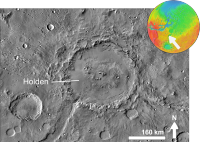Holden (Martian crater)

Crater Holden based on THEMIS day-time image
|
|
| Planet | Mars |
|---|---|
| Coordinates | 26°24′S 34°00′W / 26.4°S 34.0°WCoordinates: 26°24′S 34°00′W / 26.4°S 34.0°W |
| Diameter | 153.8 |
| Eponym | Edward S. Holden |
Holden is a 140 km wide crater situated within the Margaritifer Sinus quadrangle (MC-19) region of the planet Mars, located with the southern highlands. It is named after Edward Singleton Holden, an American astronomer, and the founder of the Astronomical Society of the Pacific. It is part of the * Uzboi-Landon-Morava (ULM) system.
Like Gusev, it is notable for an outlet channel, Uzboi Vallis, that runs into it, and for many features that seem to have been created by flowing water. It's believed that Holden Crater was formed by an impact between the Noachian to Hesperian Epochs.
The crater's rim is cut with gullies, and at the end of some gullies are fan-shaped deposits of material transported by water. The crater is of great interest to scientists because it has some of the best-exposed lake deposits. One of the layers has been found by the Mars Reconnaissance Orbiter to contain clays. Clays only form in the presence of water. There are two unit of sediments in the crater. The lower unit formed in a large lake. It is believed the lake waters originated from the crater walls/or groundwater. Water from the crater walls may have come from precipitation when the Martian climate was different. The upper unit formed when water that was ponded to the south in Uzboi Vallis broke through Holden's rim. It is believed that great amount of water went through the rim; one flow was caused by a body of water larger than Earth's Lake Huron. ]]. Some of the evidence for such a large flow of water is the presence of boulders tens of meters in size sticking above the surface. To transport such huge rocks takes a great deal of water.
Holden is an old crater, containing numerous smaller craters, many of which are filled with sediment. The crater's central mountain is also obscured by sediment. Holden Crater was a proposed landing site for NASA's Mars Science Laboratory, until Gale Crater was deemed a better landing site. Just to the north east of Holden Crater is Eberswalde Crater which contains a large delta. The lower beds of Holden are thought by some to maybe similar to materials in Eberswalde Crater. However, Holden Crater is now considered a potential landing site for the Mars 2020 rover. In the second Mars 2020 Landing Site Workshop it survived the cut and was named to be among the top 8 sites still in the running for the landing.
...
Wikipedia
